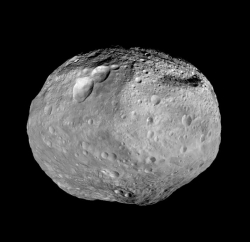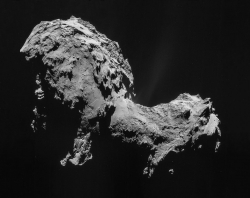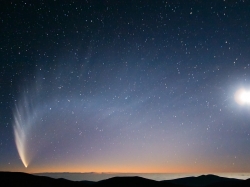Our solar system was made millions of years ago. It is made up of many things - like the sun, stars, moons, and planets. We can find a good amount about these things by looking at them in space. But, if we want to know more about how they came to be and why, we need to look at the smaller things in the solar system. Let's take a look at what these are.

Figure 1: When a larger piece of cosmic material strikes Earth’s atmosphere, it can make a bright fireball. This time-lapse meteor image was captured in April 2014 at the Atacama Large Millimeter/Submillimeter Array (ALMA). The visible trail results from the burning gas around the object.
modification of work by ESO/C Malin
MeteorsMeteors are hard pieces of rock and metal that come from outer space and burn up as they come near the Earth. They move so quickly through the air that the air burns them into a gas. This is why they are dubbed shooting stars! On a dark night, you can see about six of these an hour. This is striking because meteors are around the size of a pea. You might be wondering how we can see them if they are so small. It's really the gas around this little thing that you are seeing from Earth. Some of the time, a large number of meteors can be seen at once, which is something that is hard to predict before it happens. We think that above the whole Earth, there may be about 25 million meteors every day that are bright enough for you to see!
AsteroidsAsteroids are made up of rock and metal. They are much bigger than meteors. We used to think that they were only little planets, but soon found out that they were different. They are on the small side (smaller than the moon) and do not have enough gravity to be round shaped. They are like planets because they do follow an orbit, or a set path, around the sun. Most asteroids can be found in the asteroid belt, which is a place between Mars and Jupiter. It takes them between 3 and 6 years to travel around the sun one time. Even though there are a lot of asteroids here - we know of over one million - they are pretty spaced out. That is good for space travel because spaceships can move around without worrying about crashing into an asteroid.

This mosaic pulls together some of the best views the spacecraft Dawn had of the giant asteroid Vesta. Dawn studied Vesta from July 2011 to September 2012. The towering mountain at the south pole -- more than twice the height of Mount Everest -- is visible at the bottom of the image. The set of three craters known as the "snowman" can be seen at the top left.
NASA/JPL-Caltech/UCLA/MPS/DLR/IDA
CometsComets are made of small pieces of ice, gas, and rock. They are larger than meteors and have tails. They are like balls of ice with gas bubbles and sand grains inside. They are different from asteroids because they are made of ice. This makes them get much brighter as they get closer to the sun, creating two tails that follow behind it. They are different from meteors because meteors burn up quickly, while comets last for a long time. Even though some comets look very pretty in the sky, most of them are hard to locate from Earth because they don't get very bright or large.

Mosaic of four images taken by Rosetta's navigation camera of the Comet. The Rosetta spacecraft landed/crashed on the comet on November 12, 2014.
ESA/Rosetta/NAVCAM
Comets seem to change places in the sky at night, but they really don't follow a set pattern. Instead, they come and go in ways that are hard to guess. When we do see them in the sky, they can last anywhere from a few weeks to a few months. Most comets take over 100 years to come back to the place where they were first seen! Because they take so long to come back, it wasn't until 1705 when a scientist named Edmund Halley guessed that the comet he saw in 1705 would come back in 76 years, just like it did every 76 years before that. He was right, and Haley's comet was named after him.

In this picture taken from Paranal Observatory, we see Comet McNaught, which came closest to the Sun in January 2007, unexpectedly becoming the brightest comet in the previous 40 years.
S. Deiries/ESO